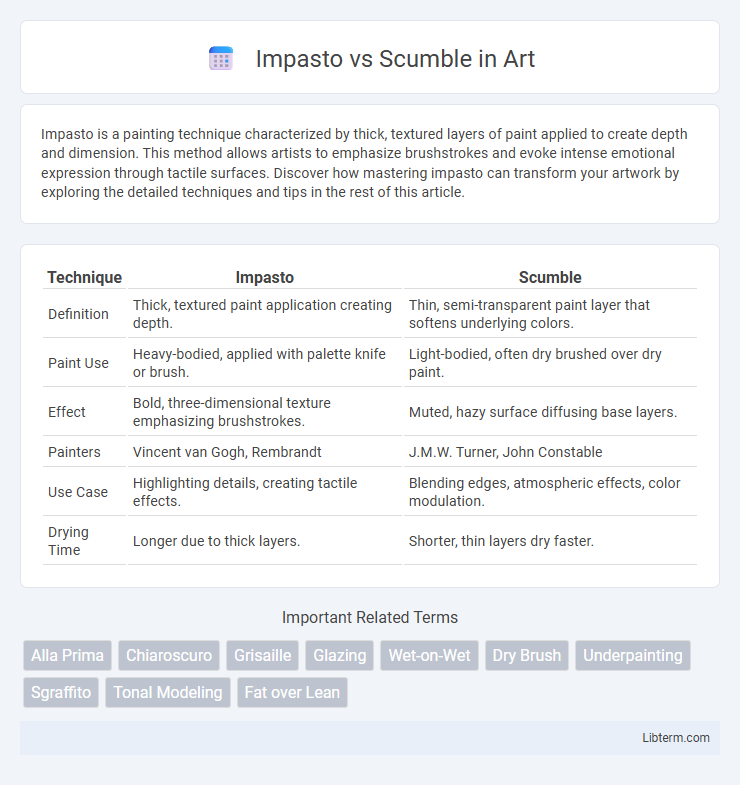Impasto is a painting technique characterized by thick, textured layers of paint applied to create depth and dimension. This method allows artists to emphasize brushstrokes and evoke intense emotional expression through tactile surfaces. Discover how mastering impasto can transform your artwork by exploring the detailed techniques and tips in the rest of this article.
Table of Comparison
| Technique | Impasto | Scumble |
|---|---|---|
| Definition | Thick, textured paint application creating depth. | Thin, semi-transparent paint layer that softens underlying colors. |
| Paint Use | Heavy-bodied, applied with palette knife or brush. | Light-bodied, often dry brushed over dry paint. |
| Effect | Bold, three-dimensional texture emphasizing brushstrokes. | Muted, hazy surface diffusing base layers. |
| Painters | Vincent van Gogh, Rembrandt | J.M.W. Turner, John Constable |
| Use Case | Highlighting details, creating tactile effects. | Blending edges, atmospheric effects, color modulation. |
| Drying Time | Longer due to thick layers. | Shorter, thin layers dry faster. |
Understanding Impasto: Definition and Techniques
Impasto is a painting technique characterized by the thick application of paint, creating textured, three-dimensional surfaces that catch light and add depth to the artwork. Artists often use palette knives or stiff brushes to build up layers of oil or acrylic paint, emphasizing the physicality of brushstrokes and enhancing visual impact. Understanding impasto involves recognizing how its dense, sculptural qualities contrast with smoother methods like scumbling, which uses thin, translucent layers for subtle effects.
What is Scumble: An Overview
Scumble is a painting technique characterized by applying a thin, semi-transparent layer of paint over a dry underlayer, allowing the colors beneath to subtly show through and create a textured, atmospheric effect. Artists use scumbling to soften edges, add depth, and produce a hazy or smoky look by manipulating the opacity and brush strokes. This method contrasts with impasto, which involves thick, textured paint application that stands out prominently from the canvas surface.
Historical Origins of Impasto and Scumble
Impasto originated during the Renaissance, famously employed by artists like Titian and Rembrandt to create rich texture and depth in oil paintings. Scumbling emerged later in the Baroque period, where artists such as Vermeer used it to produce soft, diffused light effects by applying thin, semi-opaque layers of paint. Both techniques revolutionized texture in classical art, influencing subsequent movements by enhancing visual complexity through distinct brushwork styles.
Key Differences Between Impasto and Scumble
Impasto involves applying thick layers of paint to create texture and depth, allowing brushstrokes to remain visibly raised on the canvas, while scumble uses thin, semi-opaque layers to soften or alter colors underneath without obscuring details. Impasto imparts a three-dimensional effect emphasizing light and shadow contrasts, whereas scumble achieves a muted, atmospheric quality by gently blending hues. The choice between impasto and scumble depends on the desired visual impact--impasto for bold, tactile surfaces and scumble for subtle tonal transitions.
Materials and Tools for Impasto
Impasto technique involves applying thick layers of oil or acrylic paint using tools such as palette knives, stiff brushes, and sometimes even spatulas to create tactile, textured surfaces. High-viscosity paints or medium-modified acrylics are preferred to retain the bold, three-dimensional strokes characteristic of impasto. Materials like heavy-bodied acrylics, impasto gels, and slow-drying oils enhance workability and texture, making these essential for artists aiming to achieve intense surface relief and expressive brushwork.
Essential Supplies for Scumble Techniques
Essential supplies for scumble techniques include high-quality stiff-bristled brushes and semi-transparent paint colors to achieve the desired soft, layered effects characteristic of the method. Canvas or textured surfaces enhance the ability to manipulate paint with a dry brush, allowing subtle color blending without obscuring the underlying layers. Using mediums like glazing liquid or water to thin acrylic or oil paints optimizes the scumbling process by reducing opacity and facilitating thin, broken applications.
Visual Effects: Texture vs. Luminosity
Impasto creates a tactile, three-dimensional texture by applying thick layers of paint, which enhances the artwork's depth and dynamism. Scumbling, using thin, semi-transparent layers of lighter paint over a darker base, produces a soft, glowing luminosity that subtly modulates color and light. While impasto emphasizes bold physical texture, scumble offers delicate visual shimmer and atmospheric light effects.
Famous Artists Who Used Impasto and Scumble
Impasto technique, characterized by thick, textured paint application, was famously used by Vincent van Gogh and Rembrandt to create dynamic, expressive surfaces. Scumbling, involving thin, semi-opaque layers of paint allowing underlying colors to show through, was skillfully employed by artists such as J.M.W. Turner and John Constable to achieve atmospheric effects. Both techniques enhanced the tactile quality and depth in paintings, influencing movements like Impressionism and Baroque art.
Choosing the Right Technique for Your Artwork
Impasto technique involves applying thick layers of paint, creating texture and depth, ideal for emphasizing brushstrokes and adding dramatic dimension to a painting. Scumble uses a thin, semi-opaque layer of paint to soften colors and create a hazy or muted effect, perfect for atmospheric or subtle tonal transitions. Choose impasto when you want bold texture and energy, while scumble suits artworks needing delicate color modulation and smooth visual effects.
Tips for Experimenting with Impasto and Scumble
Experiment with impasto by using thick layers of paint applied with a palette knife or stiff brush to create textured, three-dimensional effects that enhance light and shadow play. For scumbling, use a dry brush technique with a lighter, opaque color dragged lightly over a dried darker layer to achieve soft, broken color transitions and subtle depth. Combine both methods on a canvas for dynamic contrast, adjusting paint consistency and brush pressure for varied textures.
Impasto Infographic

 libterm.com
libterm.com